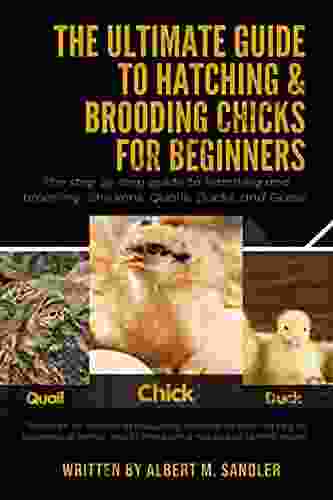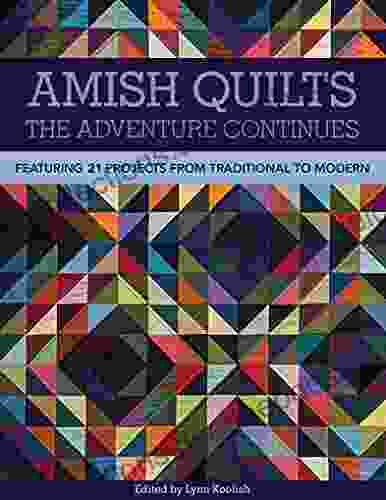The Ultimate Guide to Hatching and Brooding Chicks for Beginners

Congratulations on taking the first step towards raising your own flock of chickens! Whether you're a seasoned farmer or a first-time chicken enthusiast, this comprehensive guide will walk you through every step of the hatching and brooding process to ensure your chicks thrive. From gathering the necessary equipment to providing optimal care, we've got you covered. So, let's dive right in and embark on this exciting journey!
Getting Started: Equipment and Supplies
Before you bring your eggs home, it's essential to gather the necessary equipment and supplies to facilitate a successful hatching and brooding experience. Here's what you'll need:
4.4 out of 5
| Language | : | English |
| File size | : | 5237 KB |
| Text-to-Speech | : | Enabled |
| Screen Reader | : | Supported |
| Enhanced typesetting | : | Enabled |
| Print length | : | 91 pages |
| Lending | : | Enabled |
Incubator: This is a temperature-controlled chamber where your eggs will incubate for 21 days. Ensure your incubator is large enough to accommodate the number of eggs you plan to hatch and maintains a stable temperature of 99.5°F (37.5°C) with a humidity of around 50-55%.
Brooder: After the chicks hatch, they will need a warm and secure environment to grow and develop. A brooder provides a controlled temperature and environment for the chicks during their first few weeks of life. You can purchase a pre-made brooder or build your own using a cardboard box or a large plastic tub.
Heat Source: Chicks require a consistent heat source to maintain their body temperature. A heat lamp is a commonly used option, but you can also use a brooder plate or a heat panel. The heat source should provide a temperature gradient within the brooder, with a warmer area near the heat source and a cooler area on the opposite end. This allows the chicks to regulate their temperature by moving closer to or further from the heat.
Thermometer and Hygrometer: To monitor the temperature and humidity levels within the incubator and brooder, you will need a thermometer and a hygrometer. This will help you ensure optimal conditions for egg incubation and chick development.
Feeder and Waterer: Chicks need access to a steady supply of clean water and nutritious food. Choose feeders and waterers designed specifically for chicks and ensure they are always full.
Bedding: Clean and absorbent bedding, such as pine shavings or straw, provides a comfortable and dry environment for the chicks.
Egg Candler: An egg candler is a device that allows you to see inside the egg during incubation. This helps you monitor the egg's development and identify any potential issues.
Hatchery or Breeder: If you don't have access to fertile eggs, you can purchase them from a hatchery or a local breeder. Ensure you choose a reputable source to obtain healthy and viable eggs.
Incubation: Monitoring and Troubleshooting
Once you have gathered your supplies, it's time to set up the incubator and start incubating your eggs. Here's what you need to know:
Setting Up the Incubator: Place the incubator in a well-ventilated area away from direct sunlight or drafts. Assemble the incubator according to the manufacturer's instructions and calibrate it using a thermometer and hygrometer to ensure accurate readings.
Preparing the Eggs: Before placing the eggs in the incubator, gently clean them using a soft cloth or a specialized egg cleaner. Avoid washing the eggs with water, as this can remove the protective bloom that helps prevent bacterial contamination.
Incubating the Eggs: Place the eggs in the incubator with the pointed end down and the air cell up. Set the temperature to 99.5°F (37.5°C) and the humidity to 50-55%.
Candling the Eggs: After 7-10 days of incubation, candle the eggs to check their development. A developing egg will have a visible network of blood vessels and a dark spot that represents the embryo. Clear eggs or eggs with a floating blood ring indicate that the embryo has died.
Adjusting Temperature and Humidity: During the incubation process, monitor the temperature and humidity levels regularly. Make slight adjustments as needed to maintain optimal conditions. Generally, the humidity should be increased to around 65% during the last three days of incubation to facilitate hatching.
Troubleshooting: If you encounter any issues during incubation, such as eggs not hatching or chicks dying in the shell, refer to a trusted resource or consult with an experienced poultry farmer for guidance.
Hatching: Assisting the Chicks
The hatching process can be an exciting and rewarding experience. Here's what to expect and how to assist your chicks:
Signs of Hatching: As the chicks approach their hatching date, you may notice small cracks in the eggshells. These cracks will gradually expand until the chicks are able to break free.
Assisting the Chicks: In most cases, chicks will be able to hatch independently. However, if you notice a chick struggling to break free from its shell, you can gently assist it by carefully peeling away small pieces of the shell. Avoid pulling on the chick, as this can damage its delicate body.
Post-Hatch Care: Once the chicks have hatched, allow them to rest and dry within the incubator for 24 hours. This will help them absorb their yolk sac and gain strength.
Brooding: Providing Optimal Care
After the chicks have hatched, it's time to move them to the brooder. Here's how to provide optimal care for your growing chicks:
Setting Up the Brooder: Place the brooder in a warm and draft-free area. Spread a layer of clean bedding on the floor and install the heat source according to the manufacturer's instructions. Ensure the brooder provides a temperature gradient, with a warmer area near the heat source and a cooler area on the opposite end.
Introducing the Chicks: Gently place the chicks in the brooder and observe their behavior. Monitor the temperature and humidity levels to ensure they are within the optimal range.
Feeding and Watering: Provide the chicks with a continuous supply of clean water and a nutritious chick starter feed. Choose a feed specifically formulated for young chicks and ensure it contains all the essential nutrients they need for growth and development.
Health Monitoring: Observe your chicks daily to monitor their health and behavior. Check for signs of illness, such as lethargy, diarrhea, or respiratory distress. If you notice any concerns, isolate the affected chick and consult with a veterinarian or experienced poultry farmer for guidance.
Temperature Management: As the chicks grow and develop, gradually reduce the temperature in the brooder by 5°F (2.8°C) per week until they reach room temperature. This helps them adapt to the outdoor environment and prevents overheating.
Transitioning Outdoors: Once the chicks are fully feathered and independent, you can start transitioning them outdoors. Gradually introduce them to a protected area during the day and provide a secure shelter at night. Monitor their behavior and adjust the transition process as needed.
Raising chicks from eggs can be a rewarding and enriching experience. By following the steps outlined in this comprehensive guide, you can provide your chicks with the optimal care and environment they need to thrive. Remember to be patient, observant, and always prioritize the well-being of your feathered friends. With dedication and a passion for poultry, you'll witness your chicks grow into healthy and productive members of your flock.
4.4 out of 5
| Language | : | English |
| File size | : | 5237 KB |
| Text-to-Speech | : | Enabled |
| Screen Reader | : | Supported |
| Enhanced typesetting | : | Enabled |
| Print length | : | 91 pages |
| Lending | : | Enabled |
Do you want to contribute by writing guest posts on this blog?
Please contact us and send us a resume of previous articles that you have written.
 Novel
Novel Page
Page Chapter
Chapter Text
Text E-book
E-book Magazine
Magazine Newspaper
Newspaper Paragraph
Paragraph Shelf
Shelf Preface
Preface Synopsis
Synopsis Footnote
Footnote Manuscript
Manuscript Scroll
Scroll Bestseller
Bestseller Classics
Classics Narrative
Narrative Memoir
Memoir Reference
Reference Encyclopedia
Encyclopedia Dictionary
Dictionary Thesaurus
Thesaurus Narrator
Narrator Character
Character Librarian
Librarian Card Catalog
Card Catalog Borrowing
Borrowing Stacks
Stacks Archives
Archives Study
Study Reserve
Reserve Academic
Academic Journals
Journals Rare Books
Rare Books Special Collections
Special Collections Literacy
Literacy Study Group
Study Group Thesis
Thesis Storytelling
Storytelling Reading List
Reading List Luis Portas
Luis Portas Allison Pataki
Allison Pataki Huma Qureshi
Huma Qureshi Ellen Mitten
Ellen Mitten Darrin Doyle
Darrin Doyle Tom Alesia
Tom Alesia Wm Earle Wheeler
Wm Earle Wheeler Nolan Mccarty
Nolan Mccarty Anthony Seldon
Anthony Seldon Aanewyork
Aanewyork Kathryn Blanche
Kathryn Blanche Alice Taylor
Alice Taylor David Lafferty
David Lafferty Sasha Davis
Sasha Davis Nancy C Davis
Nancy C Davis Bryan Washington
Bryan Washington Joseph F Trimmer
Joseph F Trimmer Jonathan M Katz
Jonathan M Katz Ellen Hagan
Ellen Hagan Mali Apple
Mali Apple
Light bulbAdvertise smarter! Our strategic ad space ensures maximum exposure. Reserve your spot today!

 Joseph FosterAftermath of Sociopath: A Haunting Decade Since the Shocking True Crime Case
Joseph FosterAftermath of Sociopath: A Haunting Decade Since the Shocking True Crime Case
 William WordsworthA Comprehensive Study Guide for Hisaye Yamamoto's "Seventeen Syllables"
William WordsworthA Comprehensive Study Guide for Hisaye Yamamoto's "Seventeen Syllables" Austin FordFollow ·14.4k
Austin FordFollow ·14.4k Howard BlairFollow ·12.7k
Howard BlairFollow ·12.7k Dale MitchellFollow ·17.5k
Dale MitchellFollow ·17.5k Sammy PowellFollow ·6.7k
Sammy PowellFollow ·6.7k Joseph ConradFollow ·18k
Joseph ConradFollow ·18k Hayden MitchellFollow ·3.3k
Hayden MitchellFollow ·3.3k Paulo CoelhoFollow ·4.3k
Paulo CoelhoFollow ·4.3k Colin RichardsonFollow ·19.6k
Colin RichardsonFollow ·19.6k

 Andy Hayes
Andy HayesEmbracing Now: Embark on a Mindfulness Journey for a...
In a world...

 Heath Powell
Heath Powell100 Hymns for Violin and Guitar: A Comprehensive Guide to...
The violin and...

 Floyd Richardson
Floyd RichardsonBark In The Park: Poems For Dog Lovers
Dogs are our best...

 Douglas Adams
Douglas AdamsThe Barter Crusade: A Journey into the Realm of Exchange...
In a world driven by monetary transactions,...

 Nathaniel Hawthorne
Nathaniel HawthorneInsight Guides Explore Nice & the French Riviera...
Prepare to embark on an unforgettable journey...

 Carlos Fuentes
Carlos FuentesThe Ultimate Practical Guide to Percussion: Exploring the...
Embark on a journey into the enchanting...
4.4 out of 5
| Language | : | English |
| File size | : | 5237 KB |
| Text-to-Speech | : | Enabled |
| Screen Reader | : | Supported |
| Enhanced typesetting | : | Enabled |
| Print length | : | 91 pages |
| Lending | : | Enabled |








